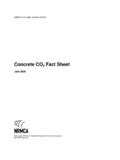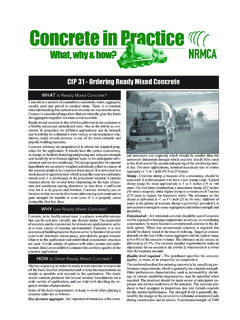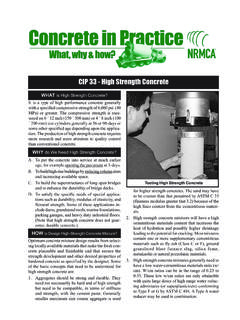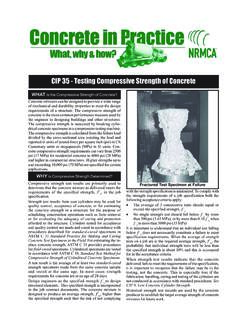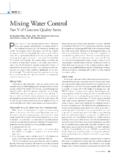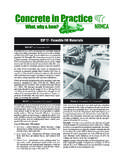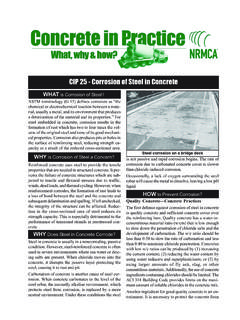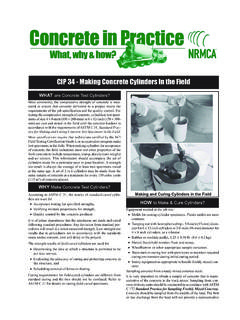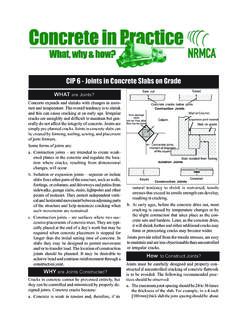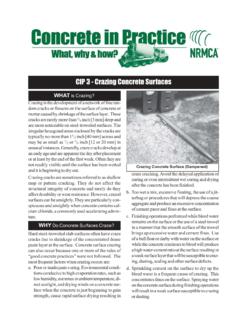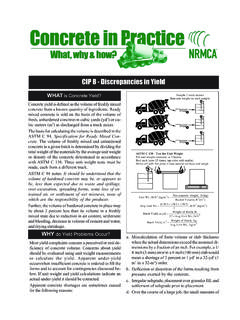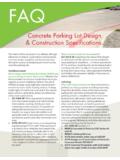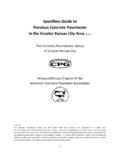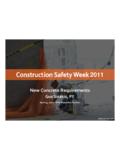Transcription of CIP 12 - Hot Weather Concreting - NRMCA …
1 CIP 12 - Hot Weather ConcretingWHAT is Hot Weather ?WHY Consider Hot Weather ?Hot Weather may be defined as any period of hightemperature in which special precautions need to betaken to ensure proper handling, placing, finishing andcuring of concrete. Hot Weather problems are mostfrequently encountered in the summer, but the associ-ated climatic factors of high winds, low relative hu-midity and solar radiation can occur at any time, es-pecially in arid or tropical climates. Hot Weather con-ditions can produce a rapid rate of evaporation ofmoisture from the surface of the concrete and accel-erated setting time, among other problems.
2 Generally,high relative humidity tends to reduce the effects ofhigh is important that hot Weather be taken into accountwhen planning concrete projects because of the po-tential effects on fresh and recently placed temperatures alone cause increased water de-mand, which, in turn, will raise the water-cement ratioand result in lower potential strength. Higher tempera-tures tend to accelerate slump loss and can cause lossof entrained air. Temperature also has a major effecton the setting time of concrete: concrete placed underhigh temperatures will set quicker and can, therefore,require more rapid finishing.
3 Concrete that is cured athigh temperatures at an early age will not be as strongat 28 days as the same concrete cured at tempera-tures in the range of 70 F (20 C).High temperatures, high wind velocity, and low rela-tive humidity can affect fresh concrete in two impor-tant ways: the high rate of evaporation may induceearly plastic shrinkage or drying shrinkage cracking,and the evaporation rate can remove surface waterHOW to Concrete in Hot Weather ?The key to successful hot Weather Concreting is:1. recognition of the factors that affect concrete; and2.
4 Planning to minimize their proven local recommendations for adjusting con-crete proportions, such as the use of water reducingnecessary for hydration unless proper curing methodsare employed. Thermal cracking may result from rapiddrops in the temperature of the concrete, such as whenconcrete stabs or walls are placed on a hot day fol-lowed by a cool night. High temperature also acceler-ates cement hydration and contributes to the potentialfor thermal cracking in massive concrete of temperature on water requirement of concrete (Ref.)
5 1)Effect of temperature on concrete setting time (Ref. 1)25026027028029030031030507090110 Concrete Temperature, FWater content, (75-mm) slump1 1/2-in. (38-mm) aggregate02468101214406080100120 Concrete Temperature, FInitial Set, , 1989 AND 2000and set retarding admixtures. Modifying the mixtureto reduce the heat generated by cement hydration,such as the use of an ASTM Type II moderate heatcement and the use of pozzolans and slag can reducepotential problems with high concrete temperature. Ad-vance timing and scheduling to avoid delays in deliv-ery, placing and finishing is essential.
6 Trucks shouldbe able to discharge immediately and adequate per-sonnel should be available to place and handle theconcrete. When possible, deliveries should be sched-uled to avoid the hottest part of the day. Limits onmaximum concrete temperature may be waived bythe purchaser if the concrete consistency is adequatefor the placement and excessive water addition is the case of extreme temperature conditions or withmass concrete, the concrete temperature can be low-ered by using chilled water or ice as part of the mixingwater.
7 The ready mixed concrete producer uses othermeasures, such as sprinkling and shading the aggre-gate prior to mixing, to help lower the temperature ofthe low humidity and high winds are predicted, wind-breaks, sunscreens, mist fogging, or evaporation re-tardants may be needed to avoid plastic shrinkagecracking in These Rules for Hot Weather Concrete1. Modify concrete mix designs as appropriate. Retarders, moderate heat of hydration cement, pozzolanicmaterials, slag, or other proven local solutions may be used.
8 Reduce the cement content of the mixtureas much as possible, while ensuring the concrete strength will be Have adequate manpower to quickly place, finish and cure the Limit the addition of water at the job site add water only on arrival at the job site to adjust the addition should not exceed about 2 to 21/2 gallons per cubic yard (10 to 12 L/m3). Adding water toconcrete that is more than 11/2 hours old should be Slabs on grade should not be placed directly on polyethylene sheeting or other vapor retarders.
9 Cover thevapor retarder with a minimum 4-inch (100 mm) layer of compactible, easy-to-trim, granular fill On dry and/or hot days, when conditions are conducive for plastic shrinkage cracking, dampen thesubgrade, forms and reinforcement prior to placing concrete, but do not allow excessive water to Begin final finishing operations as soon as the water sheen has left the surface; start curing as soon asfinishing is completed. Continue curing for at least 3 days; cover the concrete with wet burlap and plasticsheeting to prevent evaporation or use a liquid membrane curing compound, or cure slabs with water (SeeCIP 11).
10 Using white pigmented membrane curing compounds will help by indicating proper coverage andreflecting heat away from the concrete Protect test cylinders at the jobsite by shading and preventing evaporation. Field curing boxes with ice orrefrigeration may be used to ensure maintaining the required 60 to 80 F (17 to 27 C) for initial curing ofcylinders. (See CIP 9)8. Do not use accelerators unless it is common practice to avoid plastic shrinkage cracking and expeditefinishing Weather Concreting , ACI 305R, American ConcreteInstitute, Farmington Hills, Ready Mixed Concrete, NRMCA PublicationNo.
